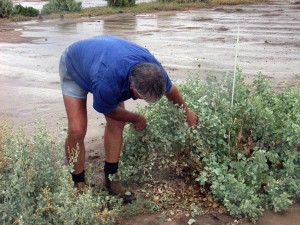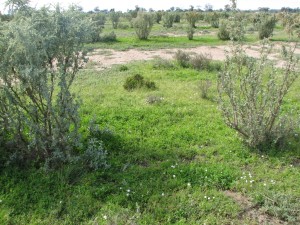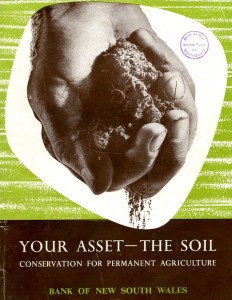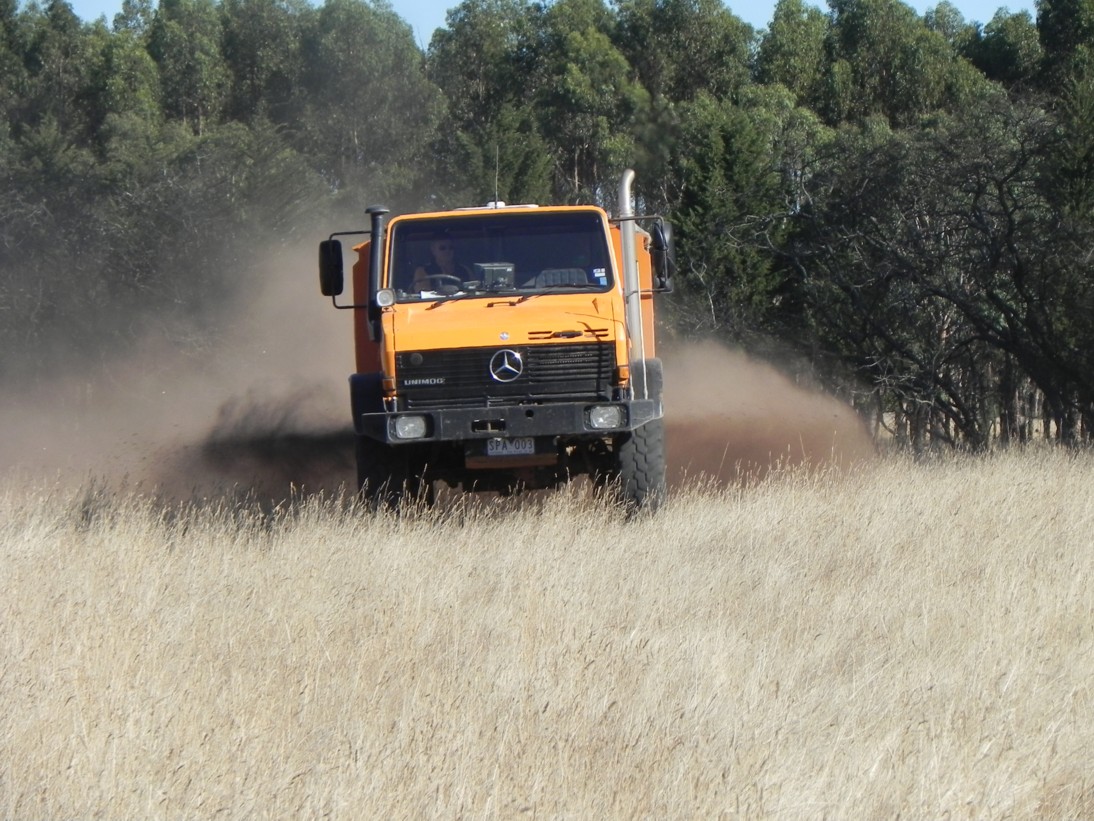Carbon flows in action
By James Nason
Southern Queensland landholders Rory and Kathy Frost have turned a long-term claypan into productive land that is now growing cattle feed with a complete cover of grass. The Frosts run a mixed cattle and sheep farming enterprise near Yelarbon on the Queensland/New South Wales border.
Over the past five years they have used their understanding of carbon flows to regenerate a claypan that used to be bare, even in normal years, into country that is now carrying total groundcover of grass. While the changes have coincided with a recent run of wet years, they cannot be explained away simply by seasonal factors. Were that the case, similar outcomes would have been achieved in wet years of the past. A longer run of high rainfall years in the 1970s produced no such changes in the same claypan.
According to Alan Lauder the author of “Carbon Grazing”, the story of how the Frosts have regenerated a long-term degraded area offers not only thought-provoking practical messages for other landholders, but interesting insights into the basics of how landscapes function and potentially valuable implications for ongoing extension programs.
Go with the carbon flow
Pictures taken over a five year period on the Frost’s property document the step-by-step process of regeneration that has occurred across their claypan. Rory says the changes were achieved by focusing on work to initiate “carbon flows” in the area, to activate the processes upon which healthy and productive paddocks rely. He likened the process of repairing a claypan to rehabilitating a former mine site. In each case the starting point is a near lifeless landscape which is slowly brought back to life below and above the ground by managing the flow of carbon.
“The natural world can’t function without carbon flows,” he explains. “Soil life, grasses and herbages all rely on carbon flows to exist. Energy, nutrients and water all follow carbon – this is the fundamental basis of all life on the planet.”
To repair the claypan, Rory and Kathy said they had to work out how to get carbon flowing into the degraded area again. That was something of a catch 22 situation. The claypan badly needed plants to ensure short-term carbon flowed in from the atmosphere via the plants to feed soil life and supply it with energy. The soil life would then restructure the soil and make it healthy and fertile again.
However, no perennial plants could establish from seed on the claypan to kick-start the ongoing carbon flows required for a healthy and productive landscape. Water was not getting into the soil to let plants establish. Water was shedding on the claypan after just 1mm of rain.
Kathy recalls that when they bought the property, they were not sure what they could do with the claypan. It was a daunting task, given it had been there for at least the 30 years that their next-door neighbour had lived in the area.
Native perennial kick-starts carbon cycle
Then they learned about the role that old man saltbush, a perennial deep-rooted shrub capable of establishing in harsh, claypan-like conditions, could play in regenerating such areas if planted as seedlings. They purchased and planted bare-rooted saltbush seedlings in 2007. These seedlings effectively started the regeneration process by cycling carbon in their immediate vicinity.
The carbon compounds deposited by the saltbush on the soil surface in the form of litter, and all of the different carbon compounds introduced below ground by the shrubs, supplied energy and a food source to allow soil life to return.
Kathy and Rory could see that the soil life was changing their soil structure for the better when they noticed the soil cracking near the saltbush about two years after it was planted. The cracking was a sign that the soil structure of the claypan was starting to change dramatically.
As water entry increased, the carbon flows also increased because other plants were able to germinate in the improved soil near the saltbush. The claypan continued to repair progressively further away from the saltbush as other plants kept entering on the edge of repaired areas. By this stage, other plants had taken over from the saltbush as the repair agent.
It is the same principle at play when normal paddocks remain productive, when management allows plants to grow after rain and maintain the flow of carbon compounds cycling through the paddock. By year five, all of the soil had improved to the extent that perennial grasses now had an environment suitable for their establishment. In year two couch was the only grass present. At year three the bulk of the claypan was still not favourable for perennial grass establishment.
Grass roots change
Another anecdote illustrates the changes that have occurred. In the first year, not long after the saltbush was planted, Rory attempted to conduct a soil test on the claypan using a vehicle mounted soil sampling unit. It could not be done because the soil was so hard it bent the sampling rod. Five years later, the roots of perennial grasses are now able to penetrate the same soil. This serves as testament to how nature utilises carbon flows to keep soil soft and to maintain productivity. The claypan between the saltbush rows was not ripped at any stage.
Kathy Frost says the decision to plant the saltbush has provided further benefits, because, without that intervention, more of the claypan would have blown and washed away, and the erosion would have ended up in the nearby Dumaresq river. She said dysfunctional landscapes became increasingly infertile with time, because they had a low potential for capturing new resources.
In support of this point, Rory said that animal manure dropped on the claypan had helped the regeneration process, as it washed across the claypan and penetrated the soil in the areas where vegetation was establishing. No applications of fertiliser have been provided during the five year period. Following the reintroduction of carbon flows, the landscape has effectively been able to capture the resources it requires. The prolific clover which has followed the improvement in water penetration has also played a role in increasing the soil fertility, which in turn has helped the perennial grasses to establish.
The claypan drops slightly towards the west. The general pattern was initially for regeneration to spread east, towards the direction from which the water came. As water ran across the claypan, it entered the soil when it reached the first of the vegetation.
The first two years saw well below average rainfall. In effect, on most occasions when rain fell, there was not enough water to get to the downside of the saltbush rows. Rory said the claypan had previously been in a continual state of drought, regardless of how much rain fell.
This highlighted the correlation between water use efficiency (WUE) and prior carbon flows. WUE is a measure of how successfully a production system converts water molecules into carbon molecules (ie the level of plant growth from supplied water). Improved WUE is a recognised driver of profit in the grazing industry. For the Frosts, the regenerated claypan is now contributing to profit as it is now able to convert rainwater into groundcover for livestock to eat.
“Wick effect” enables water penetration
As part of the regeneration process, the saltbush roots supplied a “wick effect” by allowing rain to go deeper into the soil by running down beside the roots. As other plants entered, their roots continued the wick effect across the claypan. The depth that grass roots penetrate the soil is determined by the flow of carbon available to build the roots (roots are about 45 percent carbon when dried).
Rory said he developed his current understanding of the importance of carbon flows five years ago from Alan Lauder, the founder of the Carbon Grazing principle. The Carbon Grazing principle focuses on the role of carbon flows and how to maximise them.
“It was after discussions with Alan that I came to understand how carbon flows organised so many important processes that occur in the paddock. Given that cattle are about 18pc carbon and rely on the energy transported by carbon to grow, it is easy to see the linkage between my bottom line and how successfully carbon flows are managed. Soil life utilises carbon flows to release phosphorus and make it available to plants,” he said.
Source: James Nason is a senior journalist with the on-line publication Beef Central, www.beefcentral.com




Carbon stocks versus carbon flows
Carbon stocks are a measure of the different carbon compounds present at a particular point in time. In the case of carbon trading, the amount of carbon atoms present is measured, so carbon can be traded as a commodity. In the case of organic matter, soil tests measure the stock of this carbon compound to quantify the health of the soil.
Carbon flows on the other hand are an indication of how much activity is actually occurring in the system. It could be the amount of carbon flowing into a paddock over one year or after a rainfall event. Plants allocate some of the carbon flows to below ground and the remainder goes into plant parts above ground.
The higher the flows, the higher the level of plant production. Plants release some of the carbon flows directly to soil life as part of getting the resources they require. The percentage of carbon flows released above ground for livestock to consume, is influenced by previous management and environmental conditions.
Alan Lauder suggests that the way soil samples are taken means they do not include all of the short term carbon that those focused on carbon flows would consider relevant. He believes this is because the focus generally is not on carbon flows – it is on carbon stocks, especially long-term carbon.
Long term carbon stocks do not generally change much over time and are often a reflection of what type of soil you have and where you are in Australia in terms of temperature and rainfall. It is the short term carbon stocks that are highly variable. A small percentage of the new carbon coming in each year can potentially end up in long-term carbon stocks.
On Rory and Kathy Frost’s cattle property, the claypan is likely to substantially build long-term carbon stocks over time because it is coming off a low base. Short-term carbon stocks (labile carbon) are a measure of what has happened in the recent past in terms of carbon flows. This is where the discussion on stocks and flows overlap.
The amount of labile carbon present is also an indication of the resources that will become available to plants in the near future, assuming there is adequate moisture to see them released. There are some who feel that to be able to manage and understand soil organic carbon, it is important to monitor and measure only labile carbon levels.
Carbon flows are much more influenced by management than long term carbon stocks. One reason grazing country and cropping country has a different level of soil organic carbon is because properly managed pasture has higher carbon flows over the year. Two paddocks can have equal long term carbon stocks but it is the one that has the most carbon flowing through which will have the highest level of production – a bit like capital versus cash flows.
The change in the Frost’s claypan shows all the good that carbon leaves behind as it flows through a paddock. Just as money makes money, so carbon makes carbon as the regenerated claypan demonstrates.
Implications for extension
As a producer, Kathy Frost said that it was when she understood the concept of carbon flows that current extension information became easier to understand. She said that producers had to try to pull information together, whereas scientists tended to pull in the opposite direction as they are forced to become experts in a particular field, and concentrate on just part of the overall system.
She believes this “reductionist science” has held back the connection between “carbon flows” and how the system works, and this is reflected in a lot of current extension programs. As soon as she understood the concept of carbon flows, the separate issues that extension officers talked about fitted together.
“It joined up all the dots,” she said. “I could see the big picture of how the landscape really functioned by following the path of carbon. Everything suddenly became simpler and obvious.
“Getting ground cover into perspective is a good example. Maintaining ground cover is at the forefront of current extension. Putting aside letting animals eat too much pasture after it has grown, it is carbon flows that determine the level of ground cover. This is simply because grass is about 45pc carbon when dry, so ground cover will not exist without carbon flows.
“Traditional extension would observe that the ground cover on the claypan is increasing, however modern thinkers would note that carbon flows have increased over the five years.”
Carbon flows ‘natural entry point of the debate’
Alan Lauder’s book “Carbon Grazing” is used by learning institutions including the Colorado State University in America and his approach to discussing carbon flows is set to be introduced into the curriculum of a leading Australian university in 2014. Associate Professor Allan Dale of the Cairns Institute at James Cook University says Lauder’s clear ideas about the central role of carbon stocks and flows “cut through several complex cross-cutting debates between soil scientists, carbon traders and agronomists in ways that can make practical sense to cattle producers”.
“Alan understands that securing profitability is the key to good grazing management, and that the management of carbon stocks and flows in the paddock over time drives enterprise profitability. From this, pasture and soil health, animal health, erosion management, water retention and tradeable greenhouse gas emission avoidance and sequestration all follow. Alan takes some very complex system principles and turns those into the pragmatic actions needed for producers to stay in the grazing business for the long term.”
Despite this level of support Lauder’s concepts are yet to be adopted into ongoing extension programs. He says there is a view that his work on carbon flows simply fine tunes existing extension programs, or tells the same story in a slightly different way, but he rejects these contentions. He sees carbon flows as a “natural entry point of the debate”, and believes that adding carbon flows does not discredit current extension work, and nor would it require existing extension work to change.
“It is more like adding an introductory module that helps producers and students see how all the current topics discussed fit together. It also focuses producers on something their management has some control over. We may not have any control over how much rain arrives but we do have some control over how effective it is.”
He also believes that incorporating carbon flows into extension work in Queensland would help to reduce the flow sediment and nutrients onto the Great Barrier Reef. A soon to be released report will discuss the particle size of sediment going onto the Great Barrier Reef, as a result of different land management. It would appear that better management of carbon flows will result in a lower percentage of the particle size that can kill coral. – James Nason
Claypan carbon flow restoration has historical link
By Patrick Francis
Cathy and Rory Frost’s claypan carbon flow restoration using saltbush is not a new technique, but their understanding of why it works is. The same technique was highlighted in the booklet “Your Asset – The Soil, conservation for permanent agriculture” published in 1957 by the Bank of New South Wales.

It is remarkable that a bank would consider publishing on a such a topic but it highlights an level of understanding still missing in some parts of extension and agribusiness today, that the natural resource farming relies on is its most precious asset. Much of contemporary agribusiness, extension and research is fixated on productivity increases using costly inputs that try to substitutes for soil health, soil quality and carbon flows.
The booklet’s coverage of repairing claypans, caused in the first place by persistent overgrazing particularly in dry years, describes scald reclamation experiments conducted in the Bourke (NSW) district during the early 1950’s.
“There ploughing and contour furrowing gave poor results. Best results were obtained with checker-board furrowing in half-chain squares and sowing with such species as the annuals, flat-topped saltbush (A. inflate), annual saltbush (A. muelleri), and pop saltbush (A.spongiosa), and the perennial bladder saltbush (A. vesicaria). Plants gradually spread across the open spaces when grazing is carefully controlled.”
Why the lessons from this successful research were not generally adopted across the pastoral zones particularly where soil erosion was so prevalent (Western Division of NSW and Murchison Gascoyne district WA) is difficult to understand. History suggests that despite dedicated work by soil conservation service officers in state departments of agriculture, erosion continued to worsen through the 1960s, 70s and 80s. Soil erosion in central Victoria was the catalyst for a different approach to land management with farmer initiated trials to find new solutions – the landcare movement started. It became a national program in 1990.
Landcare farming initiated a revival in approach and a method of funding trials to develop novel solutions as well as a greater understanding amongst participating farmers of causes so that true solutions rather than band-aid works were introduced.




